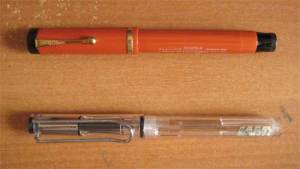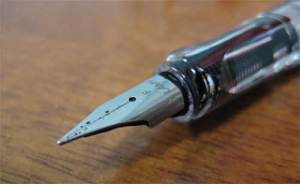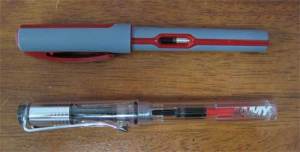An MRT employee with a sense of humour? 😀
Monthly Archives: April 2008
Reading without rhythm – 24/4/08
( )
)
Thanks TokyoMango!
– Vom leisen Inferno der Depression und von der Unheimlichkeit des Glücks.
– Vantan gets a sneak preview of the Peranakan Museum. The museum occupies the old Tao Nan school building at Armenian Street, next to The Substation.
– PingMag pays homage to Tony Silver, one of the first to identify and capture the anarchic spirit of graffiti culture on film in the 1984 Style Wars. When he went back to interview the same kids in 2003:
The reunion was different for each person. Some of them had succeeded as artists while others regretted what they had done in the past. But every single one of the kids Silver had captured in the early ’80s on his 16mm film were radiant and the filmmaker who shared that moment might have been one of the first few adults to deeply understand hip-hop culture.
– It’s nice that Newater’s winning prizes, but maybe we should learn from how the Aussies conserve water?
– Omodaka, responsible for the infectious Kokoriko Bushi video, has more music videos up on YouTube.
What is OMODAKA?
OMODAKA is the name of the project developed through a trial and error process of mutational fusion of music and motion graphics. It will knock over your existing image toward a music video by a beautiful trajectory.OMODAKA って何?
音楽とモーション・グラフィックスの突然変異的融合を試行錯誤してきた企画の名前それ が OMODAKA。あなたのミュージックビデオに対する既存イメージを美しい軌跡でひっ くり返します。

– SFS is screening Manufactured Landscapes this Saturday afternoon (details here), and Sight and Sound has a review.
– Ok, we know Makhmalbaf, Kiarostami, Majidi, Abbas, (does Satrapi count? viz. Persepolis) But who’s Rakhshan Bani-Etemad?
Internationally, Rakhshan Bani-Etemad is a directors’ director, loved by the dedicated and the educated. At home, she is a godmother of Iranian cinema who has been working for two decades and whose films are hits even as they critique Iran’s paternalism. Her work deserves to be seen abroad because she addresses many of the questions which western Europe and America have, not only about living in an Islamic state but also about the individuality and identity of all women who live under anti-woman regimes.
– In criticising religion, atheists don’t have a good explanation of why religion is still so pervasive. They seem to have ignored its narrative power, as Mark Dery argues:
Arguably, this is because it’s not about God; rather, religion is simply the only philosophical (or, if you will, mythic) language available to some Americans to articulate their discontent and their visions of social change. The Dawkins/Hitchens question—What’s wrong with religion?—is far less illuminating than the question they might have asked: What are American evangelicals really talking about when they talk about religion?
Fountain pens for kids
A colleague asked me about fountain pens today, and as she has young children who have yet to learn handwriting, she was interested in fountain pens for kids. If you’re keen too:



There’re other children’s pens too, but the Lamy abc and the Pelikano Jr are available in Singapore, while the Faber-Castell one just looks cute 🙂
The Pelikano Jr is much cheaper than the abc, but I like the look and feel of the abc. I’d have one too, if not for the fact that it’s too small for me (but just right for the Other Half 🙂 )
All pens come with ink cartridges, so you don’t have to fill from ink bottles.
Interview with Salman Rushdie
From The Independent:
Everyone, fan or foe, invokes their own imaginary Rushdie. We dream him up, and he duly takes shape: as blaspheming apostate for many still-outraged Muslims; as cocky subcontinental pseud for old-school British racists; as martyr to free speech for liberal literati. With the announcement of his knighthood, last June, this parade of straw men swelled to a seething carnival of prejudice and projection. From one corner, the pious haters swung into action: the parliament of Pakistan passed a motion against the honour as an insult to Islam. From another, the gossip-sheet haters seized on rumours of an impending divorce to renew their attritional campaign of “attacks on my physical appearance, as if I’ve ever invested anything in how beautiful I am”. From yet another, the kneejerk-leftist haters matched them all in bile: The Guardian ran a defamatory rant from a Cambridge English don that grossly misrepresented his books, his politics and his ideas with a recklessness that would shame a GCSE-level duffer.
“Truthfully, I don’t get it,” says this hard-working 60-year-old writer, clad in a writer’s comfy sweater, mulling over his burdensome double life as multipurpose scapegoat. “I just don’t understand it. I think I’ve led a serious creative life. All that I’ve tried to do for over 30 years is to be the best writer that I know how to be… It’s as if people don’t see that in some way, and that’s distressing.”
SIFF 2008 — Milky Way Liberation Front, Keronchong for Pak Bakar, After the Rain
(cross-posted on the SFS blog. To see all cross-posts, click on the “SFS Blog” tag or category)
Leaving the cinema after the end credits for Milky Way Liberation Front rolled, that was the end of SIFF 2008 for me. I was already tired when we sat down to watch that movie. It was a good way to end the festival. Milky Way Liberation Front was fun, a long string of gags that gently poke fun at indie filmmaking, film festivals and the people who participate in them.
—–
Like his first short Datura, Abdul Nizam’s Keronchong for Pak Bakar is distinguished by impressionistic editing with strong narration and the use of vocabulary with religious undertones. There isn’t a clear narrative or chronological momentum, but the mix of image and narration can be slightly hypnotic.
I agree with Tan Pin Pin’s comments about the film: the work is concerned more with Abdul Nizam’s relationship with Abu Bakar bin Ali than with the latter’s past. In fact the documentary strongly suggests that the Abdul Nizam in the film is seeking a father figure identified with the golden age of Malay cinema. This search is expressed early in the movie as a search to know more about movie legend P Ramlee, through which Abdul Nizam discovers serendipitously that the man who lensed many of his movies lived just above him. At one point, Abdul Nizam expresses in regretful tones how he discovered too late that his hardworking father had loved film stars and movies. Throughout, Abdul Nizam is extremely respectful – even protective – towards Abu Bakar.
The material used in the documentary come from two major sources. The first is clearly the recorded footage from Abdul Nizam’s conversations with Abu Bakar. The second is more mysterious — footage of a train journey up Malaysia to Penang, ostensibly taken while location scouting for a feature film on P Ramlee’s life (according to Abdul Nizam the project eventually fell through).
Empty spaces feature prominently here, partly illustrating Pak Bakar’s current solitude. When I asked Abdul Nizam why he weaved in the silent, lonely sequences from his train journey, he indicated that it was partly to convince Abu Bakar to come out of his solitude more often, perhaps to work on film again.
That documentary left the audience with far more questions about Abu Bakar Ali than answers. Why did Abu Bakar stop working on films? Why does he mostly talk about technical matters — for most of the documentary he is fiddling with an old Bolex handheld camera — and nothing about himself?
—–
I’m still surprised and a bit disgusted that SIFF screened Royston Tan’s latest short “film” After the Rain before Keronchong for Pak Bakar. Rose-tinted nostalgia and banal cliches (the father coughs to prefigure his eventual death) pliantly placed in the service of the Singapore government’s ideological imperatives. This is not a film but an advertisement, worse than the Citibank ads played before every SIFF screening because of its slick hypocrisy. Why did SIFF even bother?
SFS History in “Latent Images”
A couple of weeks ago, while reading up to prep for the Perspectives Film Festival, I discovered that Jan Uhde and Yvonne Ng Uhde had already compiled a comprehensive account of the Singapore Film Society’s history since 1958, in their book Latent Images: Film in Singapore. I contacted them, and they were kind enough to allow the SFS to reproduce the section online.
However, records from the 1960s and 1970s suggest the Film Society might have been active even before 1958. A January 1961 Sunday Times article noted that the Singapore Film Society had been “in existence for six years.” Similarly, in February 1971, film critic Koh wrote that the society “had been in existence for some 16 years.” In the 19 March 1985 edition of The Singapore Monitor, Wong Sing Yeong claimed that “the Singapore Film Society was formed in 1956 to complement the commercial cinema by screening less popular art films.”
Click here to read the complete extract.
———-
Latent Images is a key academic work on the history and development of Singapore cinema. I recommend the CD-ROM version, released 3 years after the book with some updates. It also contains video clips – interviews and footage of the former Shaw studios at Jalan Ampas.
If you’re interested, you can get it online from the Asian Film Archive.
SIFF – Quick Cuts – 8 April 2008
(Cross-posted on the SFS blog.)
Yep, got a lot to catch up on. I’ll be working backwards from my most recent viewings. Hopefully I can get to NTU’s Perspectives Film Festival (31 Mar – 4 Apr 2008) before too long.
(Darn it Stefan, don’t you sleep? 😀 )
—–
Vivid
Singapore / 2007 / 30 mins
dir. Sam Loh
Another example of a short film based on an idea rather than a story, the idea here being two strangers connecting with each other via personal items left behind in a hotel room.
(compare with: Il Mare (시월애, Siworae) (2000) and its American remake The Lake House (2006))
The material is clumsily handled though, and ends up a string of romance cliches. For instance the actors fade in and out of scenes to suggest presence, and recognise each other right away when they meet for the first time.
The sensual possibilities of the items – a shawl, cigarettes, lipstick – through which the protagonists build their imagined connection, is never fully, intimately explored. Vivid is coy to the point of emptiness. A bit odd coming from Sam Loh, who’s perhaps best known for Outsiders. This was his debut feature film, about two detectives after a necrophiliac serial killer, and was withdrawn from SIFF 2005 after MDA insisted on cuts.
—–
Diminishing Memories II
Singapore / 2007 / 60 min
dir. Eng Yee Peng
The follow up to Diminishing Memories (2005) by Eng Yee Ping, and really a study of her quixotic obsession with her own imagined idea of Lim Chu Kang.
I don’t know whether this was deliberate or not – Eng is not only the director but also appears as herself in the documentary, talking and interviewing people – but there are moments when she realises that she might simply be pursuing a falsehood. For instance, she asks a developer of a agri-tourist attraction if he was planning to dig a well, then later wonders why she asked that question when there was no well to begin with. Eng also includes an interview with her mother who, close to tears, exhorts her to stop being so obsessed with the past. However, at the end of the documentary Eng does not seem to have reached any reconciliation between her ideas of Lim Chu Kang and the present.
Eng’s techniques need more sophistication too. Diminishing Memories II looks and feels much better suited for television rather than a cinema (perhaps due to her previous working experience in a Current Affairs Unit at Mediacorp). Eng also often falls back on verbal and visual cliches, most notably in a scene at the end where she stands, looking offscreen into the distance, sunset behind her, camera angled up at her from a low position while her voiceover decribes her feelings. Eng’s singular obsession is the main attraction in this naive, melodramatic work.
Lamy Vista review
JetPens graciously sent me a Lamy Vista. In addition to stocking this excellent pen, JetPens also provides a whole range of Japanese pens at reasonable prices, with prompt service.
What’s a Lamy Vista?
When Manfred Lamy took over the company from his father, he decided to focus on creating original pens that would fuse utility with original design elements. This tradition continues with the Noto designed by Fukasawa Naoto.
The Vista is simply a clear version of the Lamy Safari. The Lamy Safari, designed by Wolfgang Fabian, was first released in 1980 as a school pen targeted at the youth market. Following Manfred Lamy’s direction, the Safari has many design features that anticipate its intended uses. Since its first production run the Safari has endured, gaining a reputation for reliability, aesthetic simplicity and smooth writing in an inexpensive package.
Packaging
The Vista comes in a translucent plastic box with slits down the length – a bit like a piano keyboard. The translucent plastic is unique to the Vista.
(On a side note, regular Safari models used to be packaged in a distinctive unfinished dark grey paper version of this box. Lamy has since reduced this to a blister pack and a PVC pouch. Ah well.)
The slits seem to tantalize the viewer, providing glimpses of the pen but not its entirety. For the Vista, the translucent plastic complements the clear pen inside while signaling that it’s a bit more expensive than regular Safari models.
On to the pen!
The Pen!
The Safari was designed primarily for the student market, so it’s meant to look attractive while being rugged, practical and cheap.
Lots of reviews have already pointed out that its ruggedness. The ABS plastic construction feels solid (for a plastic pen), even if the pen on the whole is a bit light. The Vista is no different.
(If you prefer metal, there’s an aluminium variant of the Safari – the Al-Star.)
The paperclip-like chromed clip grips tightly to almost any pocket, especially jeans and bag pockets (again, designed with young people in mind). The clip – chromed on the Vista but enameled on some Safari models – won’t scratch or tear the fabric.
The barrel has two flat surfaces that run down its length. Some point out that this helps prevent the pen from rolling off a flat surface, but the barrel’s still round enough that the pen does roll easily even on very slight inclines. So keep that Safari / Vista / Al-Star capped or posted when you put it down.
Speaking of which – posting the cap is not a problem.
The Vista, is sometimes called a demonstrator version, though this isn’t really accurate. Demonstrators are clear versions of a pen that salespeople use to show customers the inner workings of the pen. However, the Vista is its own product line. Besides, there was a Safari demonstrator in the 1980s. Unlike the Vista the demonstrator has a black inner cap and no hotstamped foil-like logo at the end of the barrel.
But what I really liked was how, even with all the above, the overall design evoked the shape and feel of classic pens such as the Parker Duofold and the Sheaffer Flattop.
The grip has two flat inclines that automatically align your hand and the pen for writing. This is probably helpful for most people, but left-handers and some with unusual writing positions may not like this.
Enough ogling – time to see how it performs.
Performance
I generally don’t like blue ink, and I didn’t want to write with the blue ink cartridge that came with the pen.
So I got a converter – the Z24 model (but anecdotes suggest the Z26 works too). Looking at the pen again, I like the accent that the red on the converter adds.
Next I flushed the pen with water. This is standard practice for me as Lamy tests all their pens with a bit of blue ink before shipping them out.
Then I filled the Vista with some J. Herbin Poussiere de Lune.
The pen writes smoothly. The nib is rigid, but this is expected from steel nibs. Lamy steel nibs do have a little bit of flex to them, so it’s not quite a nail.
I haven’t been able to confirm this yet, but other reviews and online anecdotes also suggest that the Safari/Vista won’t skip when writing even if it hasn’t been uncapped in weeks, laying down ink the moment nib touches paper.
Swapping nibs
I’m most impressed by how the feed and nib are designed to allow you to easily swap nibs.
With most pens you need to replace the entire nib section. With the Vista/Safari all you need to do is pull the nib out and push its replacement in. Dead simple.
Just to try for myself I pulled the nib out and put it back in, following the easy instructions here. Just a tip: don’t worry too much about springing the nib. Use your forefinger under the tines to exert a bit more pressure upwards while pulling the nib out.
(On a side note, I’ve actually seen a pen shop employee pull out and push in Lamy steel nibs on a Safari using pliers. I was aghast at first, despite knowing he was experienced and probably knew what he was doing. Sure enough the nib wasn’t bent and the Safari worked fine. But I wouldn’t try that myself.)
Moreover the steel nibs are inexpensive and easily available, online at the least. So it’s easy to build a collection of different nibs (haven’t you seen the italic ones?) without breaking the bank.
More practically, it also means that you don’t have to worry about spending lots of money for a new nib. Vista landed on the floor nib down? Just swap it out. Scored a cheap Safari with a busted nib at a garage sale? Just clean the pen out, swap the nib and it’s ready to write again.
In addition, Lamy has adopted this swappable nib/feed system in their other pens. So if you upgrade to a Studio or an Accent, you don’t have to throw your Lamy nibs out.
Overall
The Safari is clearly designed to appeal to young people, but it’s a great pen for anyone who’s just starting to learn the basics of using a fountain pen regardless of age.
There’re other school pens out there as well, in the same price range as the Safari / Vista. Three of the most commonly suggested alternatives are the Waterman Phileas / Kultur, the Pelikan Pelikano and the Parker 45.
While everyone naturally has their own favorites, I’d like to suggest that the Safari is superior for the following reasons:
— the Safari has a wider girth and feels more substantial in the hand than either the Pelikano or the Parker 45 (I tried a Parker 45 once and it felt like using a pencil).
— the easy availability of a wide range of inexpensive nibs that perform well. You can’t swap the nib on a Phileas. You can swap nibs on a Pelikano, but finding individual nibs is difficult. Parker 45s have a clever nib assembly that unscrews but replacements are expensive and harder to find now that the 45 is out of production.
— The Safari has a long history of its own. The Parker 45 may have been the first cartridge pen produced, but the Safari has been in production for over 20 years, with the same design that recalls classic pens of the 1930s such as the Parker Duofold and the Sheaffer Flattop (there have been only internal design tweaks). The Pelikano keeps getting redesigned, and the Parker 45 has seen some reinventions since its introduction.
— As they say – imitation is the sincerest form of flattery 😉
And if you, like me, think that a transparent pen is simply cool:
— The Vista – a transparent Safari – just costs a little more than regular Safari. There isn’t a transparent Pelikano, and Parker 45 demonstrators are collectors’ items. The Waterman Kultur is a transparent Phileas, but that pen doesn’t have all the thoughtful, well-executed design features of the Safari/Vista.
So if you’re looking for an inexpensive, reliable writer that will survive many knocks and still look good (it was awarded the iF International Forum Design Award in Hannover in 1994), there’s most likely a Safari, a Vista or an Al-Star for you.
Find the Lamy Safari, Vista, Al-Star and more! – at JetPens
BooksActually reopens!
As of yesterday at No.5 Ann Siang Road.
And they’re throwing a little cupcake party this Saturday too.
The cupcakes start sprouting from 3pm till they run out, while the tea fountain flows all day. There will be a 10% discount off all books only on Saturday, go crazy! We are stocked to the brim, with about 600 more titles added and we’ve carved out more sections: now, besides Literature, we have Critical Theory, Non-Fiction, Art, Film, Poetry, Antique, Travel Narrative and Food Narrative sections.
The new store looks better than the old one, in my honest opinion. There’s even a little outdoor area now. Go see the new store!
Life Before Death
German photographer Walter Schels was terrified of death, but felt compelled to take these extraordinary series of portraits of people before and on the day they died. His partner Beate Lakotta recorded the poignant and revealing interviews with the subjects in their final days.
Haven’t you seen these yet? Or at least read the article?
—–
There’s a lyric from a song I like:
Do you realise
that everyone you know someday will die
But instead of saying all of your goodbyes
let them know you realise that time goes fast.
It’s hard to make the good things last
You realise the sun don’t go down.
It’s just an illusion caused by the world
spinnin’ round
— Do You Realise, The Flaming Lips






